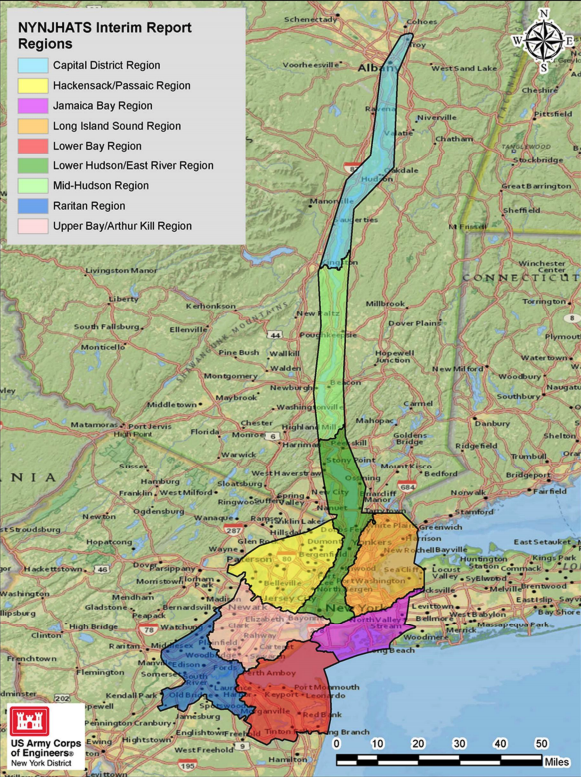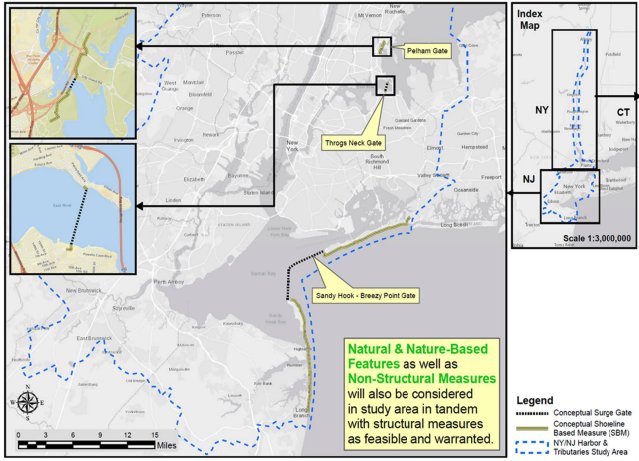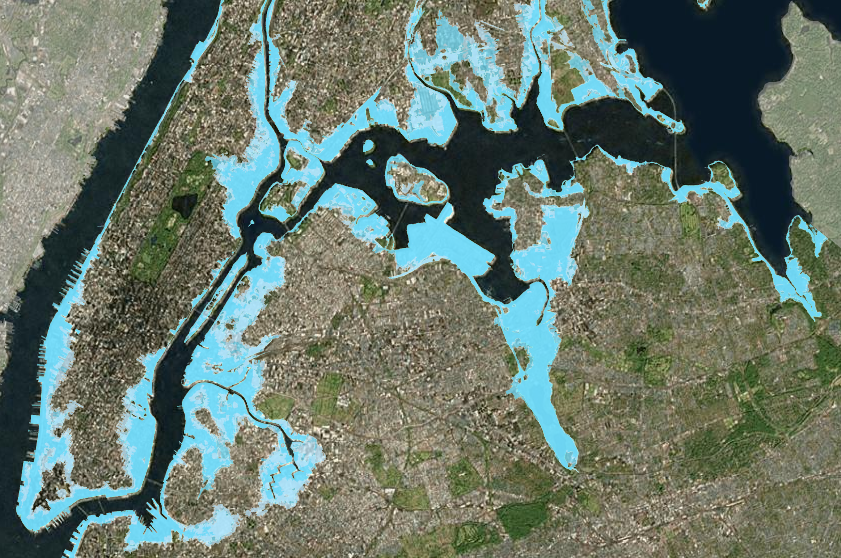Should New York Build a Storm Surge Barrier?
Sarah Fecht
State of the Planet | Earth Institute | Columbia University

It’s been seven years since Superstorm Sandy brought the city that never sleeps to a grinding halt. High tide and storm surge — the pile of water that built up in front of Sandy as she moved up the coast — combined to bury lower Manhattan under 13 feet of water. Across the five boroughs, subways, highways, and parking garages flooded; homes and businesses were destroyed, and 53 people died. It is estimated that Sandy caused $19 billion in economic damages in New York City alone.
The Superstorm Sandy anniversary also marks seven years since New York started talking about building storm surge barriers to protect itself from future storms. At a recent event hosted by Columbia University’s Sabin Center for Climate Change Law and the Earth Institute, experts discussed a study that is evaluating the feasibility of building storm surge barriers around New York and New Jersey. The panelists also debated whether such a measure is a good idea.
“Most people in the region are unaware of the study, but its results can have major economic and environmental impacts,” explained moderator Michael Gerrard, director of the Sabin Center, during his opening comments. “The Sabin Center felt it’s important to increase public understanding of what is now being examined.”

To kick off the event, Clifford Jones III, district chief of planning for the U.S. Army Corps of Engineers, outlined the different options that the Corps is looking into as part of the NY and NJ Harbor and Tributaries Focus Area Feasibility study (HATS, for short). The study’s aim is to reduce the threat of coastal storm damage along the coasts of New York and New Jersey and up the Hudson River.
The HATS study is evaluating five options for coastal protection, which range in scope and price. The most intensive option would involve constructing six miles of storm surge gates from Sandy Hook, New Jersey across the bay to Breezy Point, Queens, and along the East River. It would also include 26 miles of floodwalls, levees, and buried seawalls or dunes along nearby shorelines.
Jones said that this option would cost $62 billion, but would theoretically save the city $131 billion in damages and protect about 95 percent of the study area. Other options presented in the study may not cost quite as much, but would offer similar levels of protection.

In addition to evaluating the costs and benefits of each option, the HATS study is also considering the side effects of building storm surge barriers. That includes environmental impacts such as effects on fish and wildlife, water quality, noise and vibrations, and changes in water flow.
Another concern is that if a barrier stops storm surge from rushing into New York Harbor, “the water’s got to find a place to go,” said Jones. “Where does that water go? … We don’t want to make things worse for anybody. So if we put a big barrier in, then it could very well be that that water finds a way to adjacent areas.” He added that the study will factor in these risks when it makes its final recommendations.
Suzanne DiGeronimo, a member of the New York/New Jersey Metropolitan Storm Surge Working Group, supports building storm surge gates from Sandy Hook, NJ to Jamaica Bay, as well as in the East River, East Rockaway, and Jones Inlet. During her presentation, she gave examples of other cities that have built similar structures, including London, Houston, and New Orleans.
“There is really no other credible defense against storm surge,” said DiGeronimo.
However, Jacqueline Austermann pointed out that storm surge barriers do nothing to protect against sea level rise and tidal floods — both factors that contributed to Superstorm Sandy’s severity.
Austermann studies ice sheets and sea level rise at Columbia’s Department of Earth and Environmental Sciences and Lamont-Doherty Earth Observatory. She noted that in the New York City area, sea level is rising by 3.8 millimeters per year. Some models project that seas could rise by as much as six feet over the next 90 years — meaning low-lying areas will be flooded even without extreme events like Superstorm Sandy.

Paul Gallay, president of Riverkeeper and an adjunct professor at the Earth Institute, opposed the construction of storm surge barriers for this reason and others. He argued that the barriers don’t solve for rain-driven flooding, which is becoming more common with climate change, and that the barriers could cause catastrophic damage to river ecosystems. He said that the projects would be so expensive that they likely wouldn’t secure funding or get built for decades. “There are solutions that can be put in place a lot sooner and at a lot lower cost,” said Gallay.
Instead of storm surge barriers or gates, he suggested that New York and New Jersey could follow Boston’s lead and focus on restoring marshes and building green infrastructure, elevated parks, and other floodable architectures that can soak up water. “The water will come,” said Gallay. “We have to find a way to live with it, and we have to find a way to harness the social capital that we have.”
Gallay emphasized the need to get local communities involved in deciding how to prepare for the next Superstorm Sandy, arguing that “those closest to the risk are actually closest to the potential solution.”
In fact, the Army Corps is interested in hearing from community members — Jones said that the comments, concerns, and suggestions for alternatives would be considered and factored into the study.
While the debate over whether or not to build storm surge barriers in New York and New Jersey could easily last another seven years, Jones and his colleagues hope to present a potential solution next year, in May. If the plan is approved and funded, construction could take anywhere from 5 to 25 years.
